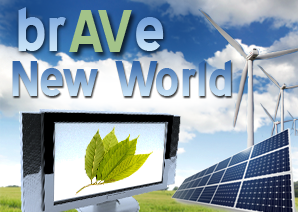The News is Out: Sustainable Standards for Stagers Are Here; Let’s Develop Some Culture!
 I bet you had no idea how lucky you are that your friendly monthly columnist is privy to the latest and greatest developments in green AV… but, guess what? You are lucky! See, I have the scoop on the fact that just two days ago, ASTM published the new “Standard Specification for Evaluation and Selection of Audio Visual (AV) and Production for Environmentally Sustainable Meetings, Events, Trade Shows and Conferences” (if you’re feeling a bit overwhelmed just with that title, I’m with you!). Although I co-chaired the committee that developed this document, what I have discovered from re-reading the standard is that there is quite a bit that has changed. And there are a few things you should know.
I bet you had no idea how lucky you are that your friendly monthly columnist is privy to the latest and greatest developments in green AV… but, guess what? You are lucky! See, I have the scoop on the fact that just two days ago, ASTM published the new “Standard Specification for Evaluation and Selection of Audio Visual (AV) and Production for Environmentally Sustainable Meetings, Events, Trade Shows and Conferences” (if you’re feeling a bit overwhelmed just with that title, I’m with you!). Although I co-chaired the committee that developed this document, what I have discovered from re-reading the standard is that there is quite a bit that has changed. And there are a few things you should know.
I will say this: you will need to be able to get past the “standard speak” and delve into the meat of the specifications. And, for the most part, the first level of the specifications can be achieved by ANYONE who commits to integrating sustainable practices into her business. I gave you the lowdown a couple of months ago on how to get a head-start on being ready for these standards. Specifically, I had suggested that you develop a sustainability policy before anything else, and provided the first steps to doing so. However, now I have a vision for you that transcends beyond just developing a simple policy, because that will simply not hold up in the years to come. I now challenge you to develop a sustainability culture. Because, without this, you might find that your organization is following all the rules, but not actually deriving long-term benefits from going through the motions.
To some, a culture might mean a group of cells growing in a petri dish, and to others, the product of art museums and concert halls, but ultimately, they mean the same thing. Culture can be defined as the full range of learned human behavior patterns. It is generally agreed that the primary development of culture is through environmental influences. We develop patterns of behavior based on the predictability, ease and interdependency of the people in our environment. If we were then to apply this to our workplace and sustainability, what would that look like?
First, you start with that policy. This is a good place to begin, because it provides a set of defined rules that the members of the culture can fall back on. It defines the rules for the environment, creates a sense of predictability. Then, you add a communications plan and message of leadership. Develop the interdependence of culture by connecting members of your organization through your vision of sustainability. As we’ve learned in the green movement, there is no possibility of achieving sustainability goals without interdependence of various teams/departments upon each other. It cannot be an isolated effort, or it will ultimately fail. Finally, culture is developed by passing the systems of the environment from generation to generation, with the awareness that future generations have the potential to shape and influence the culture in new ways. You must develop training programs and bi-directional communication plans that equally balance sustainability education with feedback and agility in adapting worthwhile suggestions.
Above all, remember that while you’re trying to fulfill the requirements of these standards, the ultimate goal is to meet a human need. In a study of 50 of the fastest growing brands in the world, brand consultant Millward Brown found that those brands which built the deepest relationships with customers achieved the greatest financial growth from 2001-2011. Furthermore, investment in these companies — the Stengel 50 — over the past decade would have been 400 percent more profitable than an investment in the S&P 500. What set these brands apart? Millward Brown’s team determined that the 50 brands touch on five fundamental human values:
- Eliciting Joy: Activating experiences of happiness, wonder, and limitless possibility
- Enabling Connection: Enhancing the ability of people to connect with each other and the world in meaningful ways
- Inspiring Exploration: Helping people explore new horizons and new experiences
- Evoking Pride: Giving people increased confidence, strength, security, and vitality
- Impacting Society: Affecting society broadly, from challenging the status quo to redefining categories
 My challenge to you, then, dear AV staging co., is… how can your company adapt these human values into your brand? Have you already? I think a great number of you out there are already doing these things. Now, just take that passion for fulfilling these human values and see where it fits within the sustainability culture framework. You just might find that that getting through that standard jargon and integrating the practices is a lot easier than you thought. If not, let me know. I’m always happy to help.
My challenge to you, then, dear AV staging co., is… how can your company adapt these human values into your brand? Have you already? I think a great number of you out there are already doing these things. Now, just take that passion for fulfilling these human values and see where it fits within the sustainability culture framework. You just might find that that getting through that standard jargon and integrating the practices is a lot easier than you thought. If not, let me know. I’m always happy to help.
Midori Connolly is CEO and Chief AVGirl of Pulse Staging & Events, Inc. in Escondido, California. She wrote the first-ever set of Sustainable Staging guidelines after discovering none existed. She is the vice-chair of the AV committee for the U.S. EPA’s Green Meetings Standards and regularly speaks and writes about corporate social responsibility and green practices in live events and meeting planning. Reach her at midori@pulsestaging.com


